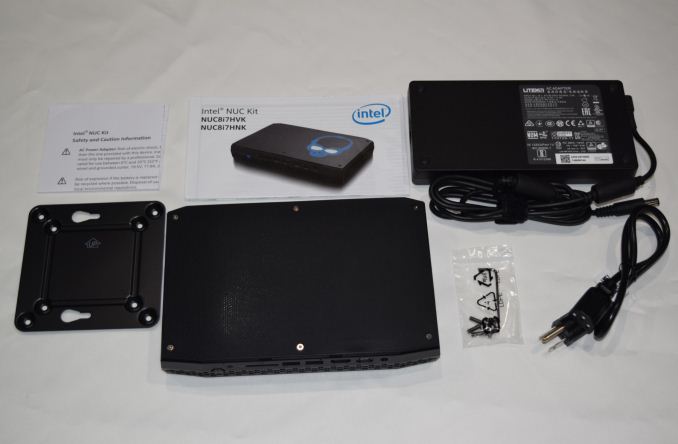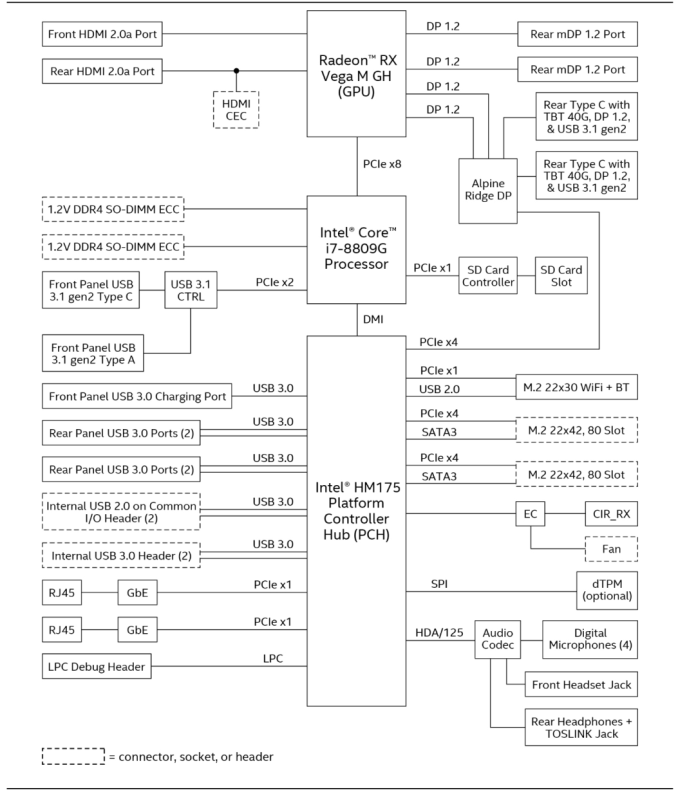The Intel NUC8i7HVK (Hades Canyon) Review: Kaby Lake-G Benchmarked
by Ganesh T S on March 29, 2018 1:00 PM EST
Intel has enjoyed great success with its NUC line of ultra-compact and small form-factor (UCFF & SFF) PCs. While the UCFF form-factor managed to provide enough horsepower for office tasks and other similar use-cases, the gaming market was not addressed. With the emergence of PC gaming as a growth driver, Intel took steps to expand the capabilities of the NUC lineup by creating the NUC6i7KYK (Skull Canyon) with a slightly larger form factor. It came with a high-end integrated GPU (Intel Iris Pro Graphics 580 with 128MB eDRAM) that provided consumers with a bit more gaming leeway compared to other NUCs. Back at the 2018 CES, Intel launched its successors - the NUC8i7HVK and the NUC8i7HNK (Hades Canyon). They are the first desktop PCs to make use of Kaby Lake-G with a Radeon GPU and HBM2 memory in the same package as the processor. Intel provided us with a sample of the high-end Hades Canyon NUC to put through our rigorous benchmarking and evaluation routines.
Introduction and Platform Analysis
Gaming systems and small form-factor (SFF) PCs have turned out to be growth segments in a desktop PC market that has been subject to severe challenges recently. Many vendors have tried to combine the two, but space constraints and power concerns have ended up as performance-limiting factors as soon as a discrete GPU is brought into the equation. We have seen interesting solutions using desktop GPUs in the recent past - namely, the Zotac E-series SFF PCs using high-end 175W TDP GPUs and coupling them with 65W desktop CPUs and liquid cooling. However, they still do not fit into the portability paradigm pioneered by the NUCs (both traditional and the Skull Canyon form factor).
Kaby Lake-G (KBL-G) ties together the processor die, discrete GPU die, and its associated HBM2 memory in one package with a single package TDP. This enables a common thermal solution and intelligent power sharing between the discrete GPU and the processor. These aspects of KBL-G are important to understand the performance of the Hades Canyon NUC. We will not discuss all the features of KBL-G in this article - readers unfamiliar with the product line can peruse our launch coverage.
Unlike Skull Canyon, which has only one SKU (NUC6i7KYK) with the Core i7-6700HQ, Intel is launching Hades Canyon in two versions - the NUC8i7HVK and the NUC8i7HNK. The NUC we are evaluating today is the more powerful of the two: the $999 VR-ready NUC8i7HVK sporting the 100W TDP unlocked Core i7-8809G. The footprint of the Hades Canyon NUCs (221mm x 142mm x 39mm / 1.2L) is slightly bigger than the Skull Canyon NUC (216mm x 116mm x 23mm / 0.69L). It is not surprising, given the additional cooling requirements for the higher TDP processor. Customizable RGB lighting for the lid is an attractive feature in the gaming market. Additional items in the product kit include a VESA mount and screws for the same and a geo-specific power cord to go with the 230W (19.5V @ 11.8A) adapter. A quick-start manual provides directions on how to add memory and SSDs to the unit.
Intel provided us a sample of the NUC8i7HVK with DDR4 SODIMMs and a couple of M.2 SSDs pre-installed. The specifications of our review unit are summarized in the table below.
| Intel NUC8i7HVK (Hades Canyon) Specifications | |
| Processor | Intel Core i7-8809G Kaby Lake, 4C/8T, 3.1GHz (up to 4.2GHz), 14nm+, 8MB L2, 100W Package TDP |
| Memory | Kingston HyperX Impact HX432S20IB2K2/16 DDR4 20-22-22-42 @ 3200 MHz 2x8 GB |
| Graphics | Radeon RX Vega M GH 24 CUs, 64 PPC 1063-1190MHz GPU, 800MHz Memory 4GB / 1024-bit HBM2 On-Package |
| Disk Drive(s) | Intel Optane SSD 800p SSDPEK1W120GA (118 GB; M.2 Type 2280 PCIe 3.0 x2 NVMe; Optane) Intel SSD 545s SSDSCKKW512G8 (512 GB; M.2 Type 2280 SATA III; Intel 64L 3D TLC) |
| Networking | Intel Dual Band Wireless-AC 8265 (2x2 802.11ac - 866 Mbps) 1x Intel I219-LM Gigabit LAN 1x Intel I210 Gigabit LAN |
| Audio | 3.5mm Combo-audio Jack Capable of 5.1/7.1 digital output with HD audio bitstreaming (HDMI) |
| Miscellaneous I/O Ports | 2x Thunderbolt 3 (rear) 4x USB 3.0 Type-A (rear) 1x USB 3.1 Gen 2 Type-C (front) 1x USB 3.1 Gen 2 Type-A (front) 1x USB 3.0 Type-A Charging Port (front) 1x SDXC UHS-I Slot (front) CIR (front) 2x USB 3.0 / 2x USB 2.0 internal headers |
| Operating System | Retail unit is barebones, but we installed Windows 10 Enterprise x64 Build 16299.334 |
| Pricing (As configured) | $999 (barebones) / $1617 (as configured) |
| Full Specifications | Intel NUC8i7HVK Specifications |
The retail NUC8i7HVK kit doesn't come with a pre-installed OS. Our evaluation was done with Windows 10 Enterprise x64 Build 16299.334 and all the latest patches installed. The launch BIOS of the Hades Canyon NUCs is already protected against Meltdown and Spectre, and hence, our evaluation was done on a fully patched system. The gallery below shows the various features of the chassis as well as the disassembly pictures for the installation of the memory and the SSD.
An important aspect to note in the above pictures include the USB headers visible in the opening beneath the top lid (perfect for third-party lids to take advantage). The presence of dual M.2 slots and dual Thunderbolt 3 ports is quite interesting, and that brings us to the platform configuration.
Platform Configuration and BIOS Features
The NUC8i7HVK uses the Kaby Lake-H Sunrise Point HM175 chipset. It provides a wide variety of I/O options. Of particular interest to us is the availability of 16 PCIe 3.0 lanes configurable as a mix of x1, x2, and x4 connections. The CPU itself has 16 PCIe 3.0 lanes. The lanes are utilized as follows:
- CPU:
- PCI-E 3.0 x8 port #2 In Use @ x8 (Radeon RX Vega M GH Graphics)
- PCI-E 3.0 x4 port #3 In Use @ x2 (ASMedia ASM2142 USB 3.1 xHCI Controller)
- PCI-E 3.0 x4 port #4 In Use @ x1 (O2Micro Integrated MMC/SD Controller)
- PCH:
- PCI-E 3.0 x1 port #2 In Use @ x1 (Intel I210 Gigabit Network Connection)
- PCI-E 3.0 x1 port #3 In Use @ x1 (Intel Dual Band Wireless-AC 8265 WiFi Adapter)
- PCI-E 3.0 x4 port #5 In Use @ x4 (Intel Dual-Port Alpine Ridge JHL6540 Thunderbolt 3 Controller)
- PCI-E 3.0 x4 port #9 In Use @ x4 (M.2 PCIe SSD) (Review Config In Use @ x2 (Intel NVMe SSD Controller))
- PCI-E 3.0 x4 port #13 In Use @ x4 (M.2 PCIe SSD) (Review Config Empty)
Similar to the Skull Canyon platform, the M.2 SSD slots' PCIe lanes are multiplexed with the SATA lanes. This allows consumers to place either PCIe SSDs or SATA SSDs in the M.2 slot. In fact, our review configuration uses the PCIe 3.0 x2 800p SSD in one slot and the SATA III 545s SSD in the other. The use of the HM175 chipset enables the I219-LM NIC in the system, and the second NIC is made possible via the I210 controller hanging off the PCH's PCIe lanes. We also have a new ASMedia USB 3.1 controller - the ASM2142 that is also present in the newer Zotac ZBOX units such as the EK71080 reviewed yesterday. Interestingly, it is connected directly to the CPU - a privilege we would rather have given to the Alpine Ridge controller. The WiFi adapter is a Wireless-AC 8265 M.2 2230 module with 2x2 802.11ac and Bluetooth 4.2. We would have preferred the newer Wireless-AC 9260 with Bluetooth 5, but, fortunately, end-users can replace this M.2 module without voiding the warranty.
The various options available in the BIOS are covered in the gallery below:
The interesting screens are in the 'Performance' tab - allowing for overclocking of the processor and memory. It is also possible to enable or disable the Intel GPU in the 'Graphics' sub-section. It is enabled by default.
In the table below, we have an overview of the various systems that we are comparing the Intel NUC8i7HVK (Hades Canyon) against. Note that they may not belong to the same market segment. The relevant configuration details of the machines are provided so that readers have an understanding of why some benchmark numbers are skewed for or against the Intel NUC8i7HVK (Hades Canyon) when we come to those sections.
| Comparative PC Configurations | ||
| Aspect | Intel NUC8i7HVK (Hades Canyon) | |
| CPU | Intel Core i7-8809G | Intel Core i7-8809G |
| GPU | Radeon RX Vega M GH Graphics (4 GB HBM2) Intel HD Graphics 630 |
Radeon RX Vega M GH Graphics (4 GB HBM2) Intel HD Graphics 630 |
| RAM | Kingston HyperX Impact HX432S20IB2K2/16 DDR4 20-22-22-42 @ 3200 MHz 2x8 GB |
Kingston HyperX Impact HX432S20IB2K2/16 DDR4 20-22-22-42 @ 3200 MHz 2x8 GB |
| Storage | Intel Optane SSD 800p SSDPEK1W120GA (118 GB; M.2 Type 2280 PCIe 3.0 x2 NVMe; Optane) Intel SSD 545s SSDSCKKW512G8 (512 GB; M.2 Type 2280 SATA III; Intel 64L 3D TLC) |
Intel Optane SSD 800p SSDPEK1W120GA (118 GB; M.2 Type 2280 PCIe 3.0 x2 NVMe; Optane) Intel SSD 545s SSDSCKKW512G8 (512 GB; M.2 Type 2280 SATA III; Intel 64L 3D TLC) |
| Wi-Fi | Intel Dual Band Wireless-AC 8265 (2x2 802.11ac - 866 Mbps) |
Intel Dual Band Wireless-AC 8265 (2x2 802.11ac - 866 Mbps) |
| Price (in USD, when built) | $999 (Barebones) $1617 (with SSD, and RAM, as configured / No OS) |
$999 (Barebones) $1617 (with SSD, and RAM, as configured / No OS) |
























124 Comments
View All Comments
astromoose - Thursday, March 29, 2018 - link
How loud is it under load?ganeshts - Thursday, March 29, 2018 - link
If you are gaming with the volume up, then it is a non-issue. On a comparative basis, it is much better than the ZBOX EK71080, but, not as good as the liquid cooled ZBOX E-series. I would say it is as loud as the Skull Canyon - but, it doesn't enter the noisy territory as much. Some hard numbers on the Skull Canyon can be found here : https://www.reddit.com/r/intelnuc/comments/7ga2q9/...Crazyeyeskillah - Thursday, March 29, 2018 - link
This would be a nice 1 fit solution for an arcade emulator cabinet. No issues with lower resolution and could essentially run anything you throw at it!Crazyeyeskillah - Thursday, March 29, 2018 - link
nevermind, the 1700$ price tag is laughableCrunchy005 - Thursday, March 29, 2018 - link
"As Configured"...they put a 118GB optane drive + a 512GB SSD on top of 16GB RAM. Optane is already not necessary.So get the Kit $999
DDR4 16GB SO-DIMM 2x8GB $167
500GB SSD $125
Windows OS $100(or less depending on how you get it)
$1391 if you need to buy windows
$1291 if you already have a windows license
06GTOSC - Tuesday, April 3, 2018 - link
That's still a lot. Yes it's fairly capable. But for $1300-1400, you can build a much more capable desktop. Yes it'll be larger. But I think space is hardly the issue for most unless you're looking for a LAN machine.xeal - Wednesday, May 2, 2018 - link
You will change your opinion *drastically* if you ever decide to live in (or even visit) Japan.TEAMSWITCHER - Thursday, March 29, 2018 - link
Reading the unwritten ... Not good for 4K gaming ... Got it.ganeshts - Thursday, March 29, 2018 - link
Even Intel is marketing this as a 1080p gaming machine - guaranteeing 60fps for most titles at that resolution.Cooe - Thursday, March 29, 2018 - link
I'm sorry, but what kind of lunatic expected Kaby Lake-G to be able to game at 4K??? Ridiculously stupid expectations are ridiculously stupid.